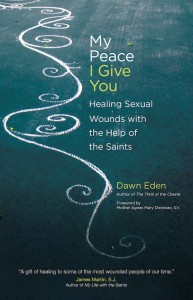I wrote yesterday about how “I have come to believe that people who have suffered trauma as a result of the abuses that are widespread in secular society—the sins committed against the family and against the dignity of the human person—are going to be vital members of the next generation of Christian witnesses.” Today I would like to tell you about one of those survivors, whose witness inspired me when I was writing My Peace I Give You. Her name is Carrie Bucalo, and she gives her witness on her aptly named website HealedByTruth.com.
Carrie writes that she was sexually victimized as a child by her father, then a Catholic lay minister. Since her abuser was a visible representative of the Church, she feels a particular burden for those who have suffered abuse perpetrated by clergy or religious, as she writes:
This scandal has made many victims feel abandoned by Christ and the Church, and I completely understand. I myself am a victim of this scandal, and I too have been pushed beyond my limits to the fringes of my faith. Yet, there must be a way for victims to continue practicing their Catholic faith with strength and even, I might add, with joy.
I admire how she writes with honesty about her struggles in the spiritual life:
Through my love-hate relationship with the cross, I am finally relieved to be experiencing many of its fruits. I’ve had to face other’s and my own darkest sins. I was, and am, very weak, I cannot even begin to tell you just how weak I really am. But just like Christ promised, he is strong in my weakness. Whether I like it or not, the very human, sometimes scandalous, Catholic Church is the source of my encounter with Christ’s redeeming and healing love. And in her teachings on faith and morals, I have been saved from countless sufferings. Now looking back on it all, I’ve seen that even if by abusive actions some of her members act outside her holiness and attempt to mar her face, Christ’s bride is still beautiful.
The reference to abusers’ attempts to mar the Bride of Christ’s face reminds me of a similar observation Pope Benedict made in his Christmas 2010 greeting to the Roman Curia: “The face of the Church is stained with dust.”
Carrie discovered the Church’s beauty first as a teenager, through the writings of Blessed John Paul II, and later as a cloistered Carmelite nun, which she was for three years before realizing that her true vocation was marriage. In the central essay on her website: “The Spiritual Journey of Healing,” she fuses insights from Carmelite spirituality with teachings from the Catechism, John Paul II, and Benedict XVI, to make some powerful points about the healing to be found through “the Memory of God”:
By becoming Incarnate, Jesus Christ, the second person of the Holy Trinity, united himself with every human being who ever existed. And, when the “fullness of time had come,” he took upon himself the sins of the world and died on the cross, conquering sin and death forever. Therefore, at the moments of our abuse, God made himself present to us, through the power of his Incarnation. He took the horror of our sins and our abuse upon himself and transformed it into a life-giving power, namely grace. He was there, suffering with us and for us on his timeless cross. He cried every tear with us, endured every wound, and answered every prayer.
I believe that it is only looking with Christ, at the whole of his memories of us, that we can find our truest identity and the fullest healing. Glancing at ourselves, in and through Christ, in and through his memories, will give us a complete picture of what happened to us, of who we are now, and of who we are called to be. As Blessed Pope John Paul II so beautifully wrote:
“Consequently, the man who wishes to understand himself thoroughly—and not just in accordance with immediate, partial, often superficial and even illusory standards and measures of his being—must with his unrest, uncertainty and even his weakness and sinfulness, with his life and death, draw near to Christ” (Pope John Paul II, Veritatis Splendor 8).
As children of our heavenly Father we are called to “draw near to Christ,” to “enter him with all of ourselves,” to “appropriate and assimilate the whole reality of the Incarnation and Redemption in order to find ourselves” (Veritatis Splendor, 8, by Pope John Paul II). Uniting ourselves to the very person of Christ, and to his memories of our life, we will begin to understand His Paschal mystery. In a new light, we will see the wounds he suffered, the scourges that were rent, the crown of thorns, and the cross he carried, because, these are our memories, our pains, our wounds, our sufferings, and our cross.
Within God’s memories, he is suffering with us and for us, doing absolutely everything he can to show us the true beauty of his face. He did not abandon any of us during our abuse…He was right there, actively participating in our suffering, doing something with our pain, at the exact moment of our abuse. He was at our side, and always holding us, just as he held his cross…it was one and the same event. … [Continue reading at HealedByTruth.com.]
Every time I reread those words of Carrie’s, I am newly awed by how deeply she, in writing them, was thinking with the Church. They remind me of Pope Benedict’s reflections at a Mass in memory of Manuela Camagni, a woman who had served in the papal household and was a member of a religious institute known as Memores Domini—Latin for “[those] in remembrance of the Lord.” The Holy Father said,
[On] the eve of his Passion, Christ renewed, indeed uplifted our memory. “Do this in memory of me”, he said, and thus he gave us the memory of his Presence, the memory of his gift of himself, of the gift of his Body and of his Blood, and in this gift of his Body and his Blood, in this gift of his infinite love with our memory we touch once again the stronger presence of God, his gift of himself. …
We, human beings, with our memory, can unfortunately only preserve a shadow of the people we have loved. The memory of God, however, does not preserve only shadows, it is the origin of life; here the dead are alive, in his life and with his life they have entered the memory of God which is life. The Lord says this to us today: you are inscribed in the name of God, you live in God with true life, you live by the true source of life. …
In this interweaving of his memory and our memory we are together, we are alive. Let us pray the Lord that we may feel this communion of memory more and more, that our memory of God in Christ may become ever more alive, and thus that we may feel that our true life is in him and that in him we all remain united. [Read the full homily on the Vatican website.]
Carrie Bucalo knows, with Pope Benedict and all the saints, that the residual pain from our darkest memories, however much it may tear at us, cannot really harm us. When God’s healing rays reach into our present, they cannot but help suffuse our past as well. Or, as another survivor, Drusilla Barron, puts it, hell doesn’t own us. We are Christ’s, and Christ is God’s (1 Cor 3:23)











